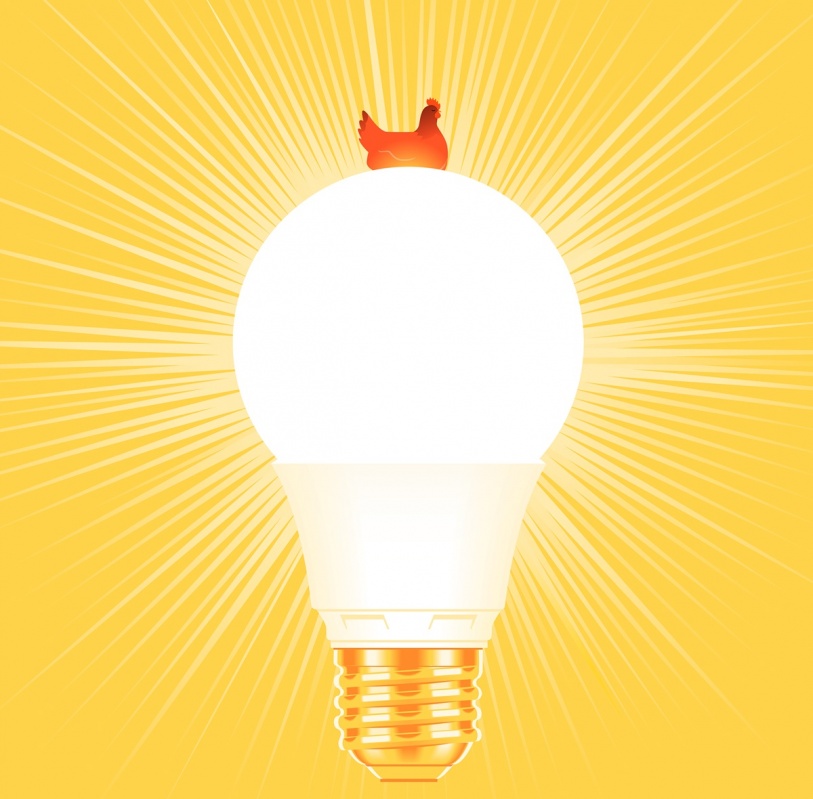Light-emitting diode bulbs cost less to operate and produce less heat than traditional incandescent bulbs, and a recent study suggests that LED lights could benefit the poultry business by enabling the production of more eggs with calmer, quieter chickens.
Jesse Huth holds a master’s degree in poultry science and has years of experience raising chickens. He also provides poultry consulting and hosts Squawk Talk, a radio show about chickens and wild birds on radio station KWVH-FM (94.1) in Wimberley. He advocates using LED bulbs in chicken houses large and small.
Huth explained that in the fall, most hens stop laying eggs, an instinctive response to decreasing daylight. This natural impulse prevents chicks from hatching during cold weather, when they would be more vulnerable. However, illuminating the chicken coop can extend daylight hours and keep hens laying all year.
“About 17 hours of light each day is ideal,” Huth said. The summer’s longest day is 16½ hours. By putting the lights on timers programmed to come on before sunrise and turn off after sunset, the hens get used to the consistent lighting.
Several lighting options are available for poultry production, including traditional incandescent bulbs, fluorescent lights and LEDs, which cost significantly more. Huth said he believes the advantages of LEDs are well worth the initial cost.
“Incandescent lights are inefficient, and they also put out a lot of heat,” he said. “When you’re talking about meat chickens, their bodies generate a lot of heat, so anything you can do to reduce that is good.”
Fluorescent lights produce a different spectrum of light from what occurs naturally, and that spectrum is based on what is visible to the human eye. This means a spectrum that appeals to humans may not work well for chickens. “The vast majority of a chicken’s brain is devoted to vision and based on the structure of their eyes,” Huth said, “and they can see a wider spectrum and have a different visual sensitivity than humans.”
Fluorescent lights also flicker rather than provide consistent illumination. This combination of flickering and the different spectrum has a negative effect on poultry that Huth has seen firsthand.
During his graduate school research, Huth visited a large poultry operation that managed approximately 50,000 chickens. Two barns were set up with fluorescent lights and two with LED lights.
“The chickens in the fluorescent-lit houses were very panicked. I opened the door, and they immediately started flapping around and trying to get away, kick-ing up dust. It was not a good situation,” Huth said. “The LED house chickens were very calm and didn’t care at all that I was there.”
Blood tests and measurements confirmed Huth’s observations: The chickens living in the LED-lit barn were less susceptible to stress than their fluorescent-lit counterparts. Chickens with lower stress levels are less fearful, don’t panic and maintain healthier immune systems.
“Over the long term, chickens that are stressed don’t eat as much, don’t focus on laying eggs and don’t put on as much meat as those that aren’t stressed,” Huth said. He expected these results based on his university studies, but real-world confirmation came from seeing thousands of chickens either clearly stressed or perfectly calm, with the only environmental difference being the lighting. This convinced him of the benefits of LEDs.
“The only downside is that the birds don’t molt, shedding off their old feathers,” Archer said. “If they don’t molt, then they don’t get new plumage. The birds may not look as pretty, but they’re still healthy.”
Gregory Archer, assistant professor of poultry science at Texas A&M University, said lighting benefits aren’t limited to commercial poultry producers. In the fall, he frequently gets calls from individuals wondering why their hens have stopped laying. “Production drops off, or they may stop laying altogether in October or November,” he said. “Then it starts coming back in the early spring.”
“If you want to produce eggs year-round, you need lighting,” Huth said. “If you’re going to do that, LED lights are the best option.”
Installing a light can mean up to four more months of daily egg production, even for a few chickens in the backyard chicken house.
——————–
Gayleen Rabakukk is a member of Pedernales EC who lives in north Austin.


